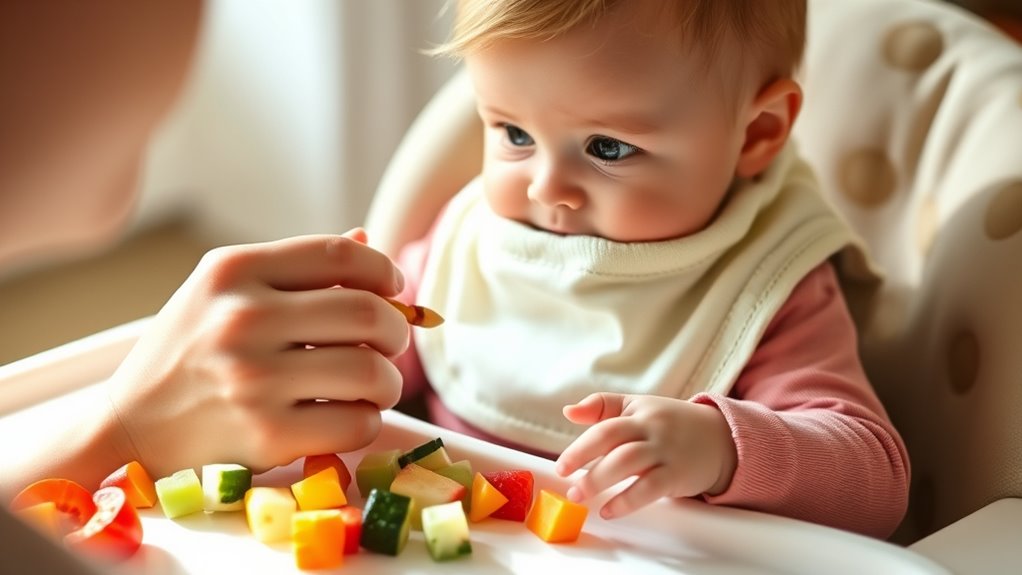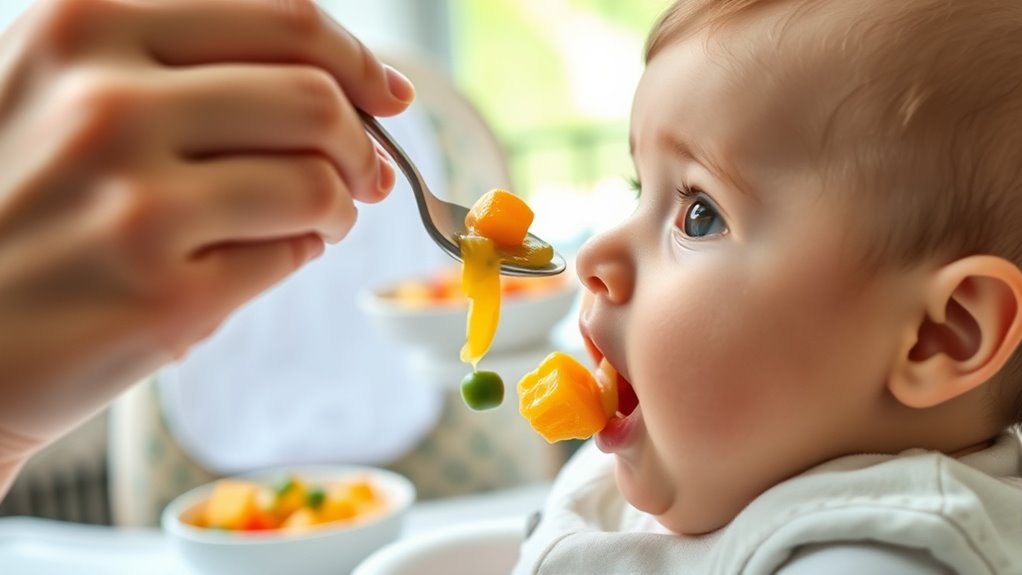To start solids safely, choose soft, small, bite-sized pieces that your baby can handle easily, reducing choking risks. Introduce potential allergens gradually and one at a time, so you can spot any reactions early. Always stay close during feeding and watch for signs of gagging or discomfort, scaling back textures if needed. By following these steps, you help your baby explore new foods safely; keep going to discover more tips for a smooth progression.
Key Takeaways
- Offer bite-sized, soft textures that are easy for your baby to chew and swallow safely.
- Introduce potential allergens gradually, one at a time, and monitor for any reactions.
- Always stay close during feeding to respond quickly to gagging or choking incidents.
- Observe your baby’s cues and avoid forcing food to promote a calm, safe eating environment.
- Consult your pediatrician before introducing new foods or allergens, especially if there’s a family allergy history.

Starting solids is an exciting milestone for your baby, but it’s important to do so safely to guarantee a positive experience. One of the key considerations is providing bite-sized textures. When you introduce new foods, make sure they’re small enough for your baby to handle comfortably. Bite-sized pieces help prevent choking because they’re easier to chew and swallow. Aim for soft, manageable chunks that your baby can grasp and explore without struggle. As your baby gets more comfortable with solids, you can gradually increase the size and texture, but always stay attentive to their cues and abilities. Remember, the goal is to encourage self-feeding while minimizing risks, so take your time and offer foods that match their developmental stage.
Alongside focusing on textures, allergen awareness is vital during this stage. It’s wise to introduce potential allergens gradually, one at a time, so you can monitor your baby for any reactions. Common allergens like peanuts, eggs, dairy, wheat, and soy should be part of your plan, but always consult your pediatrician beforehand. Keep a close eye for signs of allergies, such as hives, swelling, vomiting, or difficulty breathing. Introducing allergenic foods in small amounts and in a controlled setting helps you identify any issues early, giving you peace of mind and ensuring your baby’s safety. If your family has a history of allergies, discuss this with your doctor to tailor the best approach for your little one.
As you introduce solids, also remember that patience and observation are your best tools. Watch how your baby handles different textures and listen to their cues. If they seem overwhelmed or gag frequently, scale back to softer, smaller bites and slowly work up to more complex textures. Keep meals calm and enjoyable, avoiding pressure or forcing your baby to eat. And always stay close during feeding, especially when trying new foods or textures, to quickly respond if choking occurs. By combining bite-sized textures with allergen awareness, you reduce risks while making the transition to solids a safe, positive experience. This careful approach helps build your baby’s confidence with eating and sets the foundation for healthy, safe eating habits in the future.
Conclusion
Think of introducing solids as gently planting a seed in your child’s garden. With patience and care, you nurture it, watching it grow strong and healthy. By avoiding choking hazards and allergies, you’re safeguarding this delicate sprout from storms and weeds. Your attentive hands and loving heart are the sunlight and water that help it flourish. Trust yourself—you’re guiding this tiny seed toward a future full of vibrant, thriving life.










